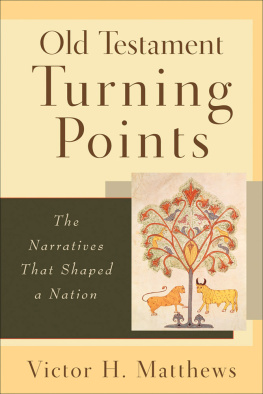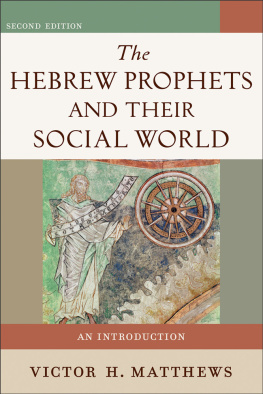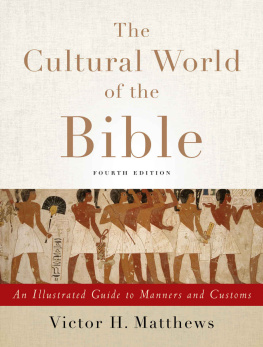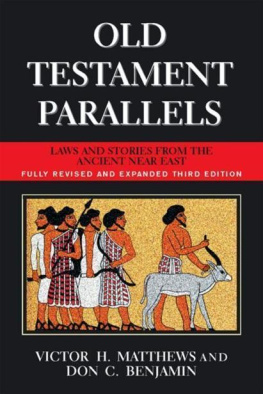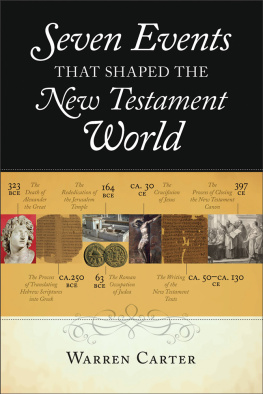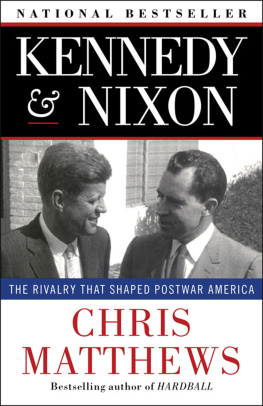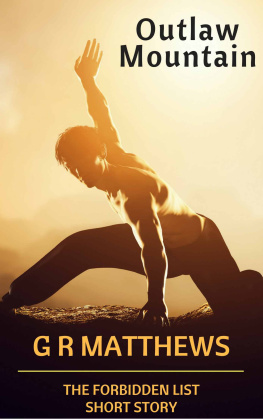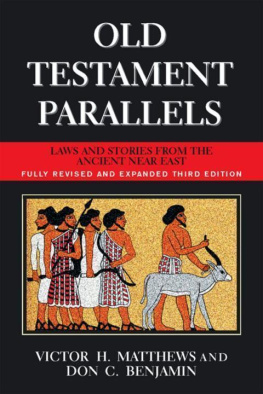Victor H. Matthews - Old Testament Turning Points: The Narratives That Shaped a Nation
Here you can read online Victor H. Matthews - Old Testament Turning Points: The Narratives That Shaped a Nation full text of the book (entire story) in english for free. Download pdf and epub, get meaning, cover and reviews about this ebook. year: 2005, publisher: Baker Publishing Group, genre: Religion. Description of the work, (preface) as well as reviews are available. Best literature library LitArk.com created for fans of good reading and offers a wide selection of genres:
Romance novel
Science fiction
Adventure
Detective
Science
History
Home and family
Prose
Art
Politics
Computer
Non-fiction
Religion
Business
Children
Humor
Choose a favorite category and find really read worthwhile books. Enjoy immersion in the world of imagination, feel the emotions of the characters or learn something new for yourself, make an fascinating discovery.
- Book:Old Testament Turning Points: The Narratives That Shaped a Nation
- Author:
- Publisher:Baker Publishing Group
- Genre:
- Year:2005
- Rating:4 / 5
- Favourites:Add to favourites
- Your mark:
- 80
- 1
- 2
- 3
- 4
- 5
Old Testament Turning Points: The Narratives That Shaped a Nation: summary, description and annotation
We offer to read an annotation, description, summary or preface (depends on what the author of the book "Old Testament Turning Points: The Narratives That Shaped a Nation" wrote himself). If you haven't found the necessary information about the book — write in the comments, we will try to find it.
Old Testament Turning Points: The Narratives That Shaped a Nation — read online for free the complete book (whole text) full work
Below is the text of the book, divided by pages. System saving the place of the last page read, allows you to conveniently read the book "Old Testament Turning Points: The Narratives That Shaped a Nation" online for free, without having to search again every time where you left off. Put a bookmark, and you can go to the page where you finished reading at any time.
Font size:
Interval:
Bookmark:

2005 by Victor H. Matthews
Published by Baker Academic
a division of Baker Publishing Group
P.O. Box 6287, Grand Rapids, MI 49516-6287
www.bakeracademic.com
Ebook edition created 2011
All rights reserved. No part of this publication may be reproduced, stored in a retrieval system, or transmitted in any form or by any meansfor example, electronic, photocopy, recordingwithout the prior written permission of the publisher. The only exception is brief quotations in printed reviews.
ISBN 978-1-4412-3802-3
Library of Congress Cataloging-in-Publication Data is on file at the Library of Congress, Washington, D.C.
Unless otherwise indicated, all Scripture quotations are from the New Revised Standard Version of the Bible, copyright 1989, Division of Christian Education of the National Council of the Churches of Christ in the United States of America. Used by permission. All rights reserved.
Contents
Preface
Tell me a story!
Tell me a story that everyone knows!
Tell me a story that echoes throughout time!
T he biblical story was never intended to be told only once. Its lively nature and its rich social texture demand constant retelling and reexamination. Recognizing this, many people make a serious commitment to read and reread their Bible. I applaud that commitment, and I hope that it becomes a lifelong pursuit. Nothing gives me greater personal pleasure than reading a familiar biblical story and discovering a new insight or a better understanding of what is going on in the narrative. However, I also realize as I read that there is an undercurrent of meaning that was originally aimed at the ancient audience. These ancient people experienced a world unlike our own, but the questions that they asked about their world, their God, and themselves are not unfamiliar to us. Of course, the very human emotions, desires, and ambitions of the characters in the biblical narrative are shaped by their cultural environment, but they can be read with some measure of understanding by modern audiences.
What may be more difficult for modern readers is identifying the insider information implicit in the words of the story and the key plot highlights that make the whole tale comprehensible. For example, when reading an epic novel like Tolkiens Lord of the Rings, a reader may enjoy individual episodes but have a more difficult time knowing when a key event has transpired that affects the overall plot. After multiple readings, however, some of these subtle aspects of the authors purpose may become clearer. Alternatively, a Tolkien scholar can provide an orientation to the text that makes even an initial reading more fruitful (and invites the reader to savor those critical moments in the narrative). It therefore is often helpful to have a guide who can explain the references to everyday life that are mentioned in the biblical story. These social signposts are there but must be pointed out to those not used to looking for them. In addition, the guide can sketch out the bigger picture that includes major themes, rhetorical techniques, and references to events that form the basic structure of Israelite identity.
With that in mind, it is my hope that readers will benefit from the following discussion of a series of major turning points in biblical tradition. Each chapter contains a synopsis of the narrative, an examination of the social and literary background of the text, and then provides an explanation and graphic depictions of what I am calling echoes of these traditions in the writings of biblical historians, poets, and prophets. I will also try to take into account that ancient audiences did not read the storiesthey heard them told. A written form of the biblical text will not begin to appear until late in their history, and even then its contents will be passed on orally either by professional storytellers or by parents telling their children what is most important about their world. It will be these tellings that will preserve the stories in the popular mind. Thus the echoes that I will point out are designed to show how the storytellers and prophetic figures attempted to touch their audience by repeatedly referring to well-known stories from their past while casting them in a new light that was relevant to their own time.
In my selection of turning points, I looked for instances that go beyond just the recorded events in the history of the people. My aim is to emphasize those moments in time and space that are retold, recalled, and reckoned as essential to the identity of ancient Israel as a nation. Each of the narratives I have chosen reaches to the very heart of the Israelites identity as a people of the covenant. Since no other ancient people was granted covenant status, it was essential that each generation of Israelites pass on to their children the essence of their cultural portfolio. This included the terms of the covenant promise; the ethical character of Yahweh in comparison to the amoral, capricious gods of their neighbors; and the justification for Gods punishment of those who violate the covenant (an aspect of theodicy).
Each chapter therefore focuses on a significant event or story that in turn provides the primary hooks upon which to hang important biblical themes and traditions as they are employed in subsequent writings. The intent is to help readers identify such basic story elements as a creation story, a wilderness theme, a contest between gods, a reference to the founding of the monarchy and Davids special relationship with God, or another example of the evil brought on the nation by Jeroboams sin in their various narrative and prophetic guises. This should open up the text to richer understanding and lively discussion. It should also demonstrate how the biblical writers over the centuries between the establishment of the monarchy (ca. 1000 BCE) and the postexilic era (ca. 500 BCE) made use of their own traditions and stories.
Each chapter contains numerous insets pointing out how particular themes and traditions are retold in the light of later history. For example, we can see how the prophets many times began their message with a variation on the phrase I brought you up out of the land of Egypt (Amos 2:10; Hosea 11:1; Mic. 6:4), echoing the exodus event and reminding the people just what they owe to God. Similarly, it is interesting to see the way in which the editor of the books of Kings provides summary judgments of the reigns of the kings of Israel and Judah based on whether each did what was right in the sight of the L ORD just as his ancestor David had done (2 Kings 18:3), or did what was evil in the sight of the L ORD , walking in the way of Jeroboam and in the sin that he caused Israel to commit (1 Kings 15:34). This transcends politics, wars, and the petty concerns of everyday administration and centers instead on what the biblical editors felt was the most important criterion for an Israelite ruler.
In becoming attuned to the way in which the biblical writers drew on their own traditions, we can more successfully appreciate the implications of their message. Thus I have often chosen to examine the structure of particular narratives, including their recurring motifs and themes, and I have analyzed the emphasis placed by the biblical writers on aspects of law, ritual purity, and religious practice. In addition, where possible I have discussed the insider viewpoint of the biblical storytellers and their original audience. To do this, I have employed literary and social scientific methods. I hope that this will allow modern readers to make more effective use of these materials as they strive to understand how the stories can be applied to our own day. In the process we will continue the tradition set forth by the biblical writers to tell and retell the old familiar stories.
Next pageFont size:
Interval:
Bookmark:
Similar books «Old Testament Turning Points: The Narratives That Shaped a Nation»
Look at similar books to Old Testament Turning Points: The Narratives That Shaped a Nation. We have selected literature similar in name and meaning in the hope of providing readers with more options to find new, interesting, not yet read works.
Discussion, reviews of the book Old Testament Turning Points: The Narratives That Shaped a Nation and just readers' own opinions. Leave your comments, write what you think about the work, its meaning or the main characters. Specify what exactly you liked and what you didn't like, and why you think so.

